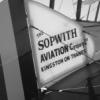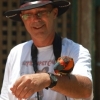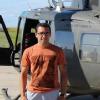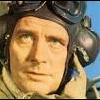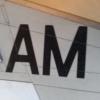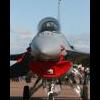Search the Community
Showing results for tags 'Catalina'.
-
PB2B-2 Catalina VH-ASA, named Frigate Bird II is suspended from the ceiling of Sydney's excellent Powerhouse Museum. I believe there is a resin conversion set for a PB2B-2 Cat and decals available to model this historic aircraft. Take a look here for the aircraft's story and a walkaround: http://warbirdswalkaround.wixsite.com/warbirds/single-post/2016/11/27/Frigate-Bird-II-A-Wandering-Cat
-
Hi all! Having recently aquired the Airfix 1/72 Consolidated PBY-5A Catalina (an aircraft I've always liked) I was doing some browsing on the interweb for various military colour schemes that I could knock up from the various decals I have floating around. One article I found was on the crash of a PBY-5 from 11 Squadron RAAF. This aircraft (A24-52) crashed while landing in Cleveland Bay, here in Townsville during 1943. Thirteen of the 19 people on board were killed, either during the crash or when the depth charges on the wings detonated. One of the survivors was Air Commodore Arthur Henry Cobby, Air Officer Commanding North Eastern Area. Thats right, the great Harry Cobby himself! I would like to model this aircraft, if possible. So, here is my question. Can I backdate the PBY-5A to a PBY-5? What are the mojor visual differences beside the undercarriage? I know that Academy do a PBY-5, but for financial reasons (that being that Mrs. TheBear would have my head on a platter) I won't even consider buying it. I also, for the same reason, don't want to buy a myriad of aftermarket products, or attempt major plastic surgery. Adding a bulkhead might be possible, but extensive detailing of the interior that won't be seen is out. I want to do this as close to OOB as possible. Thanks in advance for any advice, and fir your patience and forebearance! DennisTheBear
-
This is a report of a very personal project I started on about a year ago, and which I recently finished. It is a tribute to my great-uncle, Willem Pieter Adriaan Ditmar, and a gift to his nephew, my father, Eric Willem Roubos. Historical background In the very early morning of 26th of February 1942, Catalina Y-63 was flying over the Banka Strait, north of Sumatra. The PBY had been flying through the night on a recon of the area and its commander, Willem Ditmar, had to decide to turn back to base or continue the patrol and risk an almost certain encounter with Japanese forces. Ditmar chose the latter. The PBY was part of the forces of the MLD (Marine Luchtvaart Dienst) the Air Force of the Royal Dutch East-Indies Navy which had been involved in a struggle with the Japanese for a number of months now, since a Japanese invasion of the Dutch colony was imminent. At 6:40 in the morning, while the plane was flying just under low cloud cover to avoid detection, the PBY was jumped by two groups of three Ki-27 'Nate's' of the JAAFs 12th Air Brigade. A fight ensued, during which the gunners on Y-63 succeeded to shoot down two Ki-27s. However, the numerical superiority of the Japanese proved too much. Co-pilot Noë was hit, the plane went into a dive and was only with great difficulty brought back under control. Severely damaged the plane landed on the water, where Ditmar ordered his crew of 6 into the life boats. Y-63 sinks within seven minutes, raked with bullet holes from continued strafing. The Japanese fighters disappear and Ditmar and his crew, with the injured pilot, manage to reach the Noordelijke Gebroeders Island and eventually, on March 3, Sumatra. From there, with canoes rented from the locals, they reach Anjer on Java on the 6th. To their dismay they learn that the Japanese have landed on Java and control most of Java, including the area they have just arrived at. Ditmar and his men leave the injured pilot with a local official for treatment and continue their journey to Batavia, hoping to avoid the Japanese troops. The remaining six men split into two groups. One group is captured by locals and all three men are murdered. Ditmar's group is spared this fate but is betrayed by locals and handed over to the Japanese. Willem Ditmar was sent to a POW camp in Siam (Thailand) to work on the infamous Burma railroad. He survived the war and rejoined with his wife and his two daughters, who had been detained in Surabaya not knowing for more than three years if Willem was still alive. After the war he became the most decorated Dutch officer in the East-Indies theatre and returned to work for the Royal Dutch Navy and later for the Dutch government in South East Asia in various capacities. He died in Bangkok in a traffic accident in 1982, remaining a legend in our family. This story is based on several post-WWII publications, especially the report by mariner Gerard A. van Schooten, crew member of the Y-63, and on personal communications from family members. The Kit Academy’s PBY-5 has been around for quite some time. I think it’s still a fine kit and the only serious option if you want a PBY-5 (Revell has an antique molding which is out of production). The lines of the PBY-5 are captured well, the fit is generally excellent and the recessed detail is quite good, if a bit soft in places. The fuselage is covered in rivets, but they are quite restrained and look good under a coat of paint. The kit does disappoint when it comes to the finer details, a general issue with Academy kits of this vintage: Interior detail is minimal, the engines are very basic and the propellers are nothing like the real thing. As this was to be a special project I decided to shell out the extra cash on some aftermarket parts to correct these areas. I acquired the QuickBoost replacement engines, props and cowlings, Eduard’s photo-etch (for PBY-5A, but many items are of use) and MiniWorld brass .50 machine guns for the blisters. Construction Yes, it starts with the cockpit! Eduard’s photo-etch really improves this area as it really is quite bland. The cockpit floor requires carving up to make the parts fit and the I substituted the horizontal bar on which the yokes sit by an n-shaped piece of wire that more accurately represents the real thing. There is a gap behind the bulkhead which allows you to see into the void of the fuselage, but nothing can be seen with the cockpit window in place so I left it. The observer position has a few PE parts to spruce up the machine gun supports. After installing the six small side windows I closed up the fuselage. Fit is pretty good with the exception of the area behind the cockpit. I had to use some Mr. Surfacer 500 here and rescribe the lost detail in the area. The wing assembly consists of six pieces which form a middle segment containing the engine nacelles and two outer segments. They go together very well with just a hint of Mr Surfacer 500 required to remove the seams between the segments. I taped off the area to avoid losing the fabric detail while sanding the seams. The nacelles require a bit of filler as well and a few swipes with a sanding stick. The triangular pieces that form part of the float areas on the wing tips were another matter: They left huge gaps with the wing tips and needed quite a bit of filler to get a smooth result. At this point I had to start considering the build sequence. I usually put as much of the model together before I start painting, but the floats and wing supports were rather fragile pieces and I estimated their chance of snapping off at some point during later construction work was 100%. They also got in the way of masking, so I decided to paint the wings and fuselage separately and put them together only after decaling. I drilled some holes for the antennas and aerial wires ( I always forget to do this and end up having to do it after painting – the pine vice will slip and…), then added the PE corrugated ‘shield’ in the nose. After some fettling I pushed it in a it just stuck – no glue required. To the paint shop! Painting First step was to do the preshading. I have only used this technique a few times and I find it a very easy way to add some interest to a model. On a big kit like the Catalina it is a great way to break the large surfaces, so I set to work and an hour later I had a rather patchy and fearsome looking amphibious creature (I know, the PBY-5 is not amphibious…)! On towards the real painting then. All my references on the Catalina indicated that the MLD planes had ‘milky white’ undersurfaces. Unfortunately, this is not a color any brand carries in their range, so I made my own by taking a fresh bottle of Gunze flat white and adding a few drops of yellow to it (my thanks to FlevoDecals for suggesting this). My milky white needed about three thin layers to cover the preshading just enough to shine through (I’m afraid it doesn't show up very well in the photos). This was followed by masking off the white, and it was at this point that my references started to fail me. Although there are many photographs available of MLD PBY-5s, I have been unable to find a picture of my subject, Y-63. This wouldn't be such a problem if the MLD had been consistent in painting its Catalinas, but my references showed they were anything but. Among the differences are the demarcation between white and grey, the color used to overpaint the orange triangles, the color of the prop hubs, the exhausts, the antennas and the painting demarcations on the floats and surrounding areas. Almost no MLD Catalina is exactly the same, and without photographs it is impossible to know which combination of options Y-63 featured. However, it also meant nobody could prove me wrong if I were to guess, so that’s what I did. Undoubtedly someone will sent me a photograph of Y-63 after reading this and prove me wrong on all counts! After making my choices, it was on to painting the upper surfaces. My references told me to use ‘Dark blue-grey’, the MLD description of the color. I hit the internet and the consensus was that Dark Blue-grey was actually identical to the well-known Dark Sea Gray, so that’s what I used. On removing the masking I was unhappy with the demarcations on the fuselage to I spent quite a bit of time remasking and respraying, but the end result was very satisfying. I left the finish slightly patchy to allow for the fact that these planes were used in tough conditions. Next up was masking the overpainted orange triangles on the upper wing surfaces and the orange rudder. I sprayed these with Dark Sea Gray with some black in it (yes, I’m aware this is cheating – I should have used lightened DSG on the whole plane and ‘fresh’ DSG on the triangles…). The little V-shapes on the fabric area of the wing were masked and sprayed yellow. On Revell’s PBY-5 kit these are supplied as decals in red but on a number of my photographs they very clearly have a light color that really contrasts with the dark color of the wing, so I decided on yellow. I think it looks goods, it adds some color to the plane but at the same time blends in pretty well. I polished the surface with a 6000 grit micro mesh cloth, then applied a few light coats of Future on the areas that would receive decals, which are few. Both Dutch Decal and FlevoDecals have sets that include the PBY-5, but FlevoDecals very importantly adds a full set of serial numbers, so it was easy to go beyond the included versions and create Y-63. These are some of the best decals I have worked with; there is virtually no carrier film around them. I only used some MicroSol and they settled beautifully into the panel lines and rivets. The horizontal stabilizers were also painted in this stage. Test fitting had shown they fit very well, and as they are large I decided to leave them off until the end of the build so they would not get in the way. I neglected to attach the cowlings before painting the wing assembly. Silly, as I had to respray the demarcation a few times to get it to line up exactly with the nacelle that is attached to the wing. While I had acquired QuickBoost’s cowlings, I ended up not using them as their diameter is about 2mm smaller than the nacelle! Photographs clearly show they are the same width. I don’t know how an aftermarket part can get it so wrong. I ended up using the kit parts, rescribing the very soft detail on them and they ended up looking perfectly fine. In future I will do a bit more research before buying what is supposedly a ‘direct replacement’ upgrade part… Construction continued With the main assemblies completed I returned to the smaller parts. Still lots to do! The floats required a lot of clean up: The idea is that you insert the thin supports before you glue them together, catching them between the float halves. This I felt was a recipe for disaster, and in addition would make cleaning up the very obvious seam a major pain. However, my solution was far from perfect! I cut off the vertical main support from the floats themselves. This allowed me to clean up the seam on the floats, as well as the sink marks on the supports. So far so good, but it did leave me with a nasty butt joint to attach the two together again. They would break a number of times throughout masking and attaching them to the wing in the days ahead… On studying a movie I found of the PBY-5s in use with the MLD I noticed that they carried not the rather standard single .50 cal in each blister (which I had acquired already) but a dual .303 Browning setup. The .50 cals went in to the spares box. It was an opportunity to reuse some of the PE Eduard had kindly provided to spruce up the kit parts (in combination with plastic card), and I got some Master brass .303 barrels to make the dual setup more convincing. I used a similar combination of Eduard PE, card and Master brass for the front gun. The Eduard PE for the blisters is really meant to represent .50 cals but no one will know. Right? Right. Ok – there is no way around it – you are gonna have to attach that wing to that fuselage! I’ve never been lucky with models that feature spindly supports, and this kit would be no exception. It started off fairly well – the fuselage fits perfectly into the central recess in the wing. Pleased with myself, I forgot to do the obvious (can you guess what it is?) and went on towards the part I dreaded most: The supports. I started on the starboard side. Not a problem – perfect fit! Port side then, and that’s where it all went wrong: Both supports were too short by over 2mm. I slapped myself for not checking alignment after gluing the wing on top of the fuselage. I checked, corrected, checked, corrected, checked, measured, corrected, in the process breaking off all four of the supports again. After finally getting the right alignment I decided that it would be a good idea to let the glue set for a night before continuing. The next day I attached the supports again. Starboard, again, not a problem. Port? Would you believe it? Still a 2mm gap! I checked alignment again, and, satisfied that that was not the problem, proceeded to flood the gap between the supports and wings with a mix of superglue, Mr Surfacer and Tamiya liquid cement. My concoction created a permanent bond (probably the strongest on the entire model!), and after two days of sanding, cleaning, respraying, and more sanding, cleaning and respraying, I was very proud and happy with my now winged Catalina! Final Construction Quite a lot of this really. Main challenge were the cowlings – the use of the resin engine means you can’t use the mating surface on the nacelles as they are too deep and I had to rely on gluing the circumference of the cowlings instead. This, it turned out, was a lousy idea as the weight of the resin engines meant the thin mating surface did not provide enough strength to glue them properly to the nacelles. I decided to create a new mating surface using the back of the resin engine blocks. For this I had to remove the half-circle shaped areas on the nacelles, and by building up the layers using thin plastic sheet I finally got a nice, big, smooth mating surface. All my efforts had resulted in some spilled glue so some more respraying was required. A final piece of aftermarket I used were Red Roo’s fishtail exhausts. These are cast in resin and look quite good, although they are not as crisp as some Czech items of this kind. I had to sand the attachment points quite a bit to get a good fit to the engine nacelle. The fishtails are a bit of conjecture from my side again; I know from photos that some MLD PBYs had them, and they make the plane look a bit different, so there we go. Other bits and bobs went on quite easily; stabilizers, antennas, wires, machine guns, blisters, turret, fuel ejection pipes. I sprayed the entire kit with a mixture of 80/20 Vallejo matt and Future, and removed the Montex masking (great item, no-brainer on a kit like this) on the clear parts. The final items on the to do list were the PE wind shield wipers (attached with Future) and some Little Cars lights to represent the landing lights. They were taped over with clear cellotape to represent the glass. After some touch up I had a completed PBY! Conclusion Academy’s PBY-5 is still an excellent kit. With a bit of aftermarket it can be turned into a great kit, and it really has no significant vices to speak of. I really enjoyed this build from start to finish. After a long car and boat journey from Norfolk to The Netherlands, the revived Y-63 made it to my parents' house where it currently has a place of honor in the living room. I'm very happy with the result and so is my dad! References Bosscher, P.M. (1990) De koninklijke mariene in de tweede wereldoorlog. Part 3. Van Wijnen, Franeker, 490 pp. Geneste, W.J. J. (1992) MLD-er met twee bronzen kruizen. Mars et Historia 26(3): 57-61 Meijer, H. (2008) Voor dapperheid onderscheiden. Nieuwsbrief Vrienden Legermuseum 16(1): 12-13 Postma, T, Visser, G., Van Schooten, G.A. (????) De Catalina Y 63 door de Jappen neergeschoten. http://www.visser-maritiem.nl/Catalina%20Y%2063%20%20(1).html Womack, T. (2006) The Dutch naval air force against Japan: the defense of the Netherlands East Indies, 1941-1942. McFarland & Company, Jefferson, NC, 207 pp.
- 32 replies
-
- 27
-

-
OK so here is A model I just pulled out of the stash...An Airfix Catalina from 1963.........with a ton of missing parts,a couple of missing sprues and an entire wing lost to the stars But anyway I'm having a go at it and might make a scrapyard dio for it.. sprues:
-
Hi fellow modellers, this is my last finished project. It´s the nice PBY-5A Catalina from Academy in 1/72. i added some extras like Eduard PE and Starfighter decals to depict the first allied airplane to land in Guadalcanal in 1942. Althought I don´t think it carried any bombs, I choose to use some on my model. Build is very straightforward. It was painted with Testors acrylics and oil washed. Smoke stains were made with pastel chalks. I hope you like it and every comment and critics are welcomed! Best regards from Uruguay! Ignacio
- 21 replies
-
- 42
-

-
All, Every now and again I go back to the DK Decals main website and check (in hope) that new decals are on the way. I can happily announce that two new Catalina decals sheets are being produced, however as yet the decal sheet and instruction lay-out are yet to be fully published. Two of Qantas' famous "Double Sunrise" Cats are included on 72020, which having worked for the airline for over 27 years I'm am truly excited.. http://dkdecals.cz/ Thanks Franta - nice one my friend. Cheers .. Dave.
-
Hi everyone, at last I've finished my 1/48 Catalina, it was supposed to be completed for the Lesser Built Air-Forces Group Build, but didn't quite make it!! Original thread http://www.britmodeller.com/forums/index.php?/topic/234973320-norwegian-148-pby5-catalina/ . After a little research in to Norwegian Catalina use, (helped hugely by Nils ( Vingtor ), I was surprised to find a RoNAF Catalina which used my initials as it's squadron code, so, being a vain type ;-), that's the one I've finished it as. Sorry about the quality of some of the pics, it is a real struggle to take anything half decent without distortion, but that's due to the limitations of the Kindle I use to take photo's with and the size of the completed model. Oh, and by the way, unless you fit some internal lighting, don't bother with adding any internal detail to the kit supplied parts! Thanks for looking. Kirk
- 13 replies
-
- 17
-

-
Never too big. Czech company HpH has announced that its designers are working on a 1/32nd PBY-5A Catalina resin kit - ref.32021L Source: http://www.hphmodels.cz/index.php/en/shop-2/produkty-hph-models/modely-v-meritku-1-32/pby-5a-catalina-v-meritku-1-32-detail V.P.
-
Pics mine from the aircraft based at Duxford
- 4 replies
-
- 1
-

-
- Consolidated
- PBY
-
(and 1 more)
Tagged with:
-
The Duxford-based Consolidated PBY5A Catalina has a slightly more modern cockpit than the a wartime Catalina, but it might still be of interest: An interactive panorama of the Catalina cockpit - lables for all the switches and instruments will follow. This is part of a complete virtual tour of all five sections of the Catalina fuselage, and there will be another panorama, overlooking the Catalina, taken from one of the huge blisters. Also online is an interactive panorama of an English Electric Lightning cockpit, and a virtual tour of an English Electric Lightning Canberra - cockpit, bomb aimer station, and navigator station. Next to come is a very detailed panorama of a Spitfire Mk IX cockpit.
-
- 2
-

-
- Consolidated
- PBY
-
(and 4 more)
Tagged with:
-

New Digital Decal Releases from Oldmodels Decals
Oldmodels Decals posted a topic in The Rumourmonger
New Digital releases Australian MRH90 1/72 and 1/144 Newly released in Digital range (previously only available as Inkjet) RNZAF Hudson NZ theatre 1942 1/48 and 1/72 RNZAF Hudson Fiji/Pacific 1942 1/48 and 1/72 RNZAF Catalinas 6 Sqn 1943-44 1/48, 1/72 and 1/144 RNZAF Catalinas 6 Sqn 1944-45 1/48, 1/72 and 1/144 RNZAF Catalinas 5 Sqn – 3 OTU 1944-45 1/48, 1/72 and 1/144 RNZAF Catalinas 5 Sqn Post WWII 1/48, 1/72 and 1/144 RNZAF NH90 in 1/144 As always these are available through my website www.oldmodelsdecals.com and through TradeMe (for NZ customers). Please note that the Australian MRH90 sets will only be available through the website or direct contact (see website for e-mail address). To find the Australian aircraft on my website see the page “Australian / other Non-NZ a/c” (two pages above “NEWS!”) John Oldmodels Decals -
New: RNZAF Catalinas - 3 more schemes to complete the set (to go with 6 Sqn 44-45 (PYB-5 and PB2B-1) set previously announced): 6 Sqn early schemes in Pacific in 1943-44 (PYB-5) 5 Sqn and 3 OTU in Pacific in 1945 (PB2B-1) 5 Sqn post war (PB2B-1) Available in 1/48, 1/72 and 1/144 As always available from my website www.oldmodelsdecals.com
-
Latest releases from Oldmodels Decals: B170 - RNZAF 41 Sqn 1960s - 1/72 and 1/144 Venom FB1 - 14 Sqn RNZAF operated 43 of these leased from the RAF during the Malaysian crisis. 1/48 and 1/72 TEAL Catalina - ZK-AMP was used over a two year period to survey Pacific routes including the famous "Coral Route" flown by TEAL later Air New Zealand. 1/72, 1/48 Available through my website John www.oldmodelsdecals.com
-
The Lauridsen collection is a growing airworthy collection of classic types that is currently based at Buckeye Municipal Airport in Arizona. It's planned to move the collection to a new purpose built facility at Gila Bend Municipal Airport shortly. During my visit there wasn't another sole in sight, no gates or barriers either. The Invader greats visitors as they arrive and isn't part of the collection so I guess it'll be staying at Buckeye when everything else moves. There's also an Avenger present but this was locked away in the hanger so it wasn't possible to get any shots. As a bonus when visiting you're treated to plenty of F-16 action as the local squadrons as Luke AFB blast over at about 3000 feet. Invader & Stang by tony_inkster, on Flickr Dakota by tony_inkster, on Flickr Invader by tony_inkster, on Flickr Invader by tony_inkster, on Flickr Invader by tony_inkster, on Flickr Invader by tony_inkster, on Flickr Catalina by tony_inkster, on Flickr Trader by tony_inkster, on Flickr Flying Boxcar by tony_inkster, on Flickr Flying Boxcar by tony_inkster, on Flickr B-25 Mitchell by tony_inkster, on Flickr Albatross by tony_inkster, on Flickr

